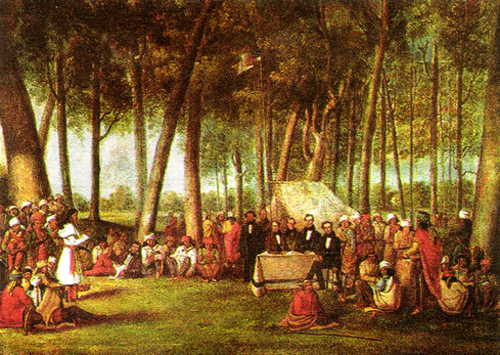Kee-Waw-Nay Potawatomi Village council between Potawatomi leaders and U.S. government representatives in July 21, 1837 to settle details for the impending removal of the Potawatomi from northern Indiana. Painted by George Winters.
David Wallace was born in 1799 in Pennsylvania, grew up in Ohio, and moved with his family to Brookville, Indiana, in 1817. After an education at West Point, Wallace returned home to study and take up the practice of law. He rose through the political ranks, serving three terms in the Indiana House from 1828 through 1831 and then became Noah Noble’s lieutenant governor.
In 1837, Wallace ran for governor. He ran in support of the proposed internal improvements program, touted to criss-cross the state with canals which would provide transportation for Hoosiers and their goods to both southern and eastern markets. Wallace was certain that the new projects would quickly pay for themselves and promised voters that any new tax would be no more than the cost of an “extra hen and chickens.”
Wallace and the Indiana General Assembly were disastrously wrong. The state borrowed so much money to finance the improvements that it went bankrupt in 1840. By 1839, Wallace tried to introduce austerity measures but they proved too little and too late.
David Wallace has also gone down in history as the governor behind the forced removal of the Potawatomi Indians from northern Indiana. The General Assembly had already petitioned the US Congress to be able to enforce the 1830 Indian Removal Act in the Hoosier state; Wallace was the governor who carried out the plan. When tribal members refused to leave, Wallace sent an armed militia to round them up from their homes and lands and forcibly march over 800 men, women, and children to Kansas. The forced exile became known as the Trail of Death.
Wallace was voted out of office in 1840. One year later, however, he was elected to represent Indiana in the US House of Representatives. His time on the Ways and Means Committee finally yielded positive results – Wallace voted to give $30,000 to an inventor named Samuel F. B. Morse for work on his telegraph. Unfortunately for Wallace, he met resistance back home for his support of such a foolish enterprise; again voted out of office, he returned to Indiana and worked as a lawyer and judge.
Source: Linda Gugin and James St. Clair, eds., The Governors of Indiana (2006).
A Moment of Indiana History is a production of WFIU Public Radio in partnership with the Indiana Public Broadcasting Stations. Research support comes from Indiana Magazine of History published by the Indiana University Department of History.























